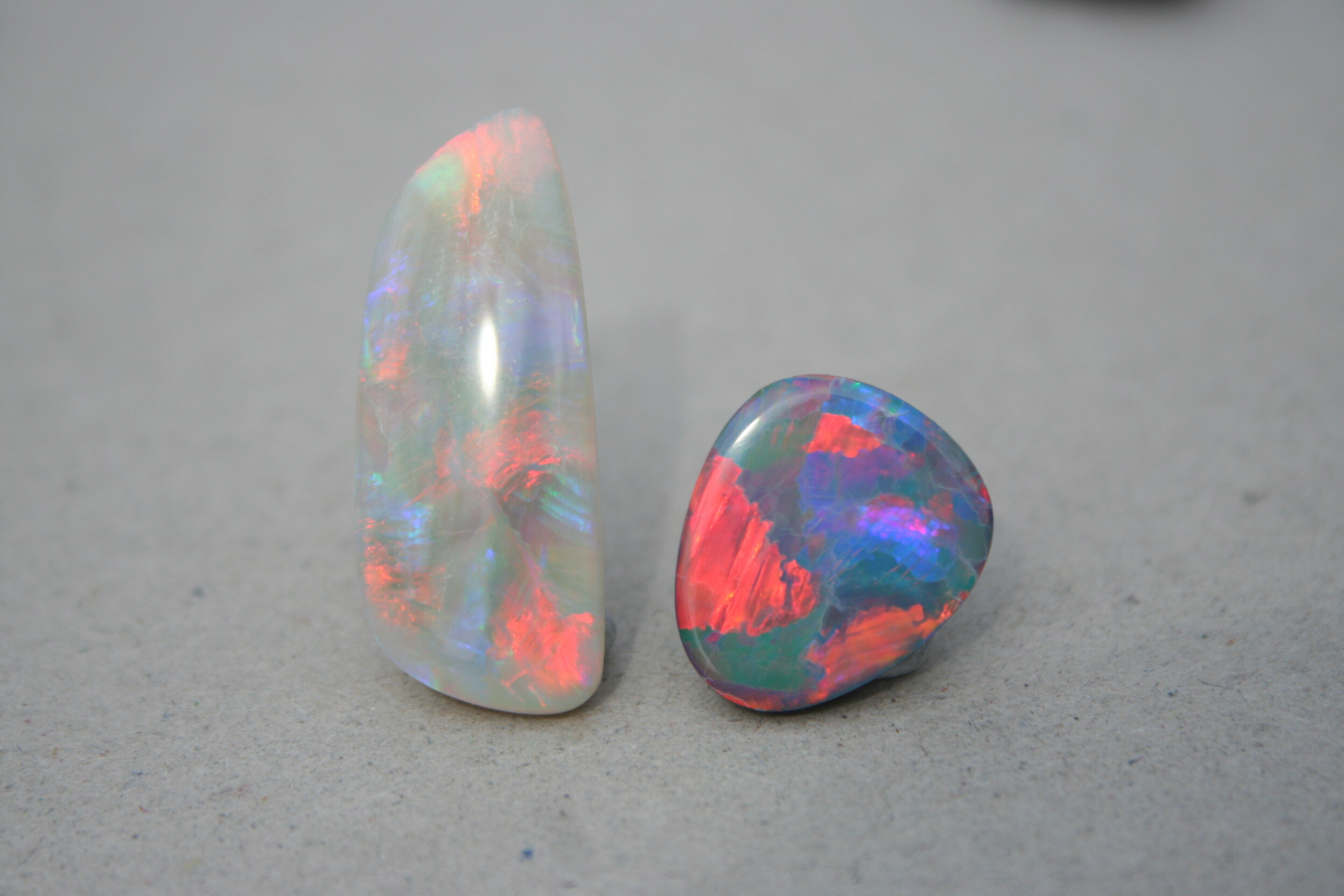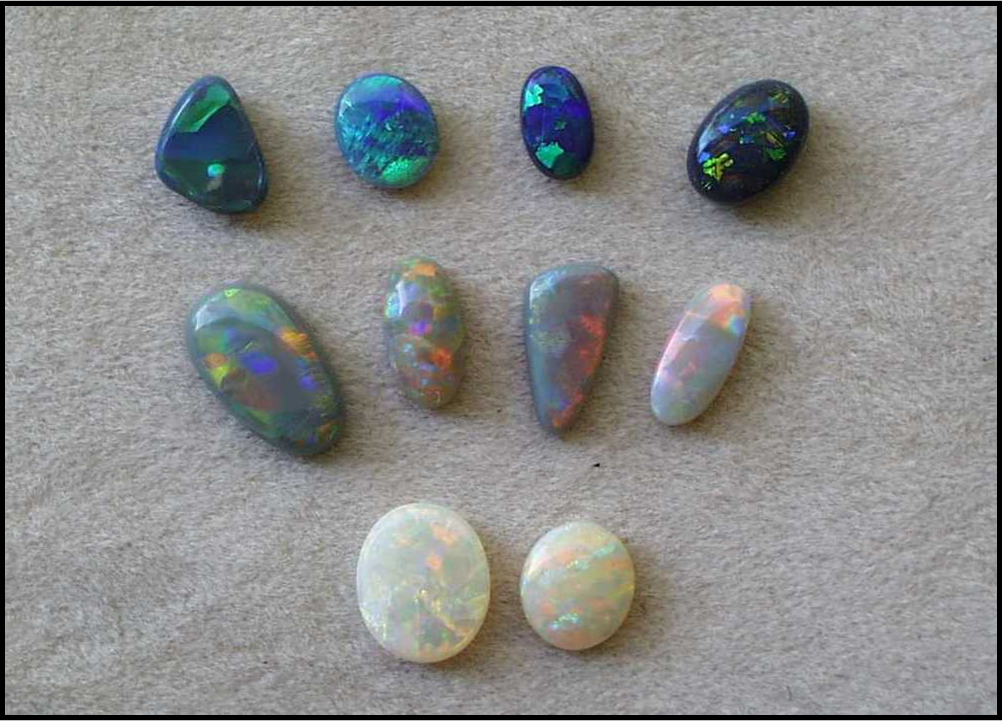Opal Appreciation - Attributes of Precious opal
One of the things I am often asked when it comes to looking at precious or noble opal, or trying to place a value on precious opal, or even just to describe a precious opal is “how do I do that?”
So it does not necessarily matter whether I am writing a valuation or appraisal document, or whether I am writing a description for an advertisement for a particular piece of opal or just trying to convey to someone else what it looks like.
Perhaps the bottom line is that all precious opals possess different “Attributes”.
There are perhaps two issues here in describing precious opal, they are, do I just want to talk about an opal to someone else, or do I want to write a formal document which describes a precious opal.
We have already looked briefly at how to value an opal and have discussed the four ‘c’s of precious opal. However it is appropriate now to delve a little deeper in the appreciation of precious opal. As already mentioned, opal comes in so many different forms, types and varieties that sometimes this can be difficult. For now lets concentrate on Precious Noble Opal, that is simply opal which show the phenomena of Play-Of-Colour (POC).
ATTRIBUTES OF PRECIOUS, NOBLE OPAL
We will discuss the attributes in no particular order of value or hierarchy, these issues will be further discussed in later blogs.
Lets first look at what an opal looks like at first glance, lets consider how an opal will “FACE”
PLAY-OF-COLOUR - a discussion about what Play-of-colour is, how it is different to other ‘phenomena’ seen in gemstones.
BRIGHTNESS - a discussion about how bright, brilliant, vivid, vibrant or intense the Play-of-colour or the FACE is.
COLOURS - a discussion about what the ‘spectral’ colours are that are seen
PATTERN - a discussion about how the individual colour grains are arranged in the face
BODY COLOUR - a discussion about the background, base colour or tone, most often, black or white, but can be coloured with a ‘hue’ (see below)
OTHER CONSIDERATIONS
There are two other attributes that need to be discussed in this section.
COLOURED WITH A “HUE” - a Discussion about precious opal that has a distinct hue to its body colour- Precious Mexican Fire Opal.
TRANSPARENCY - a Discussion about transparent and translucent precious opal colloquially known in Australia as “crystal opal”.
A precious black opal showing a very bright red multi-coloured play-of-colour. Note that all the ‘spectral colours are visible in this gemstone.
PLAY-of-COLOUR
So what do we mean in gemmology when we talk about a Play-of-colour, which more often we just refer to as POC?
The Play-of-colour of precious or noble opal refers to the description of the dancing colours of an opal that change and move as the gemstone is viewed in different directions by an observer.
These colours are not only seen on the surface of an opal (as is often the case with the chatoyancy or iridescence seen in other gemstones) the colour grains and the Play-of-colour is as much more three dimensional attribute of precious opal That is to say that the colour goes “into the stone”.
In the early historical discussion regarding the investigation into opals play-of-colour, the Australian scientists who discovered the cause of this POC phenomenon commented on a number of things.
The colour seen in the POC is related to small “grains" or colour patches
The colours seen in each of these grains change with the movement of the stone or the different angle of viewing by the observer.
The colours seen appear to be “spectrally pure” colours or the colours seen in a rainbow.
As the gemstone is moved, if a red colour is observed, then as the stone is rotated, the colour can move down through the visible spectrum, from red to orange to yellow to green as if moving through the visible spectrum.
A free form light opal on the left showing a moderately bright Play-of-colour, and a free form dark opal on the left showing a bright Play-of-colour. It can be argued that the darker body colour (Tone) of the opal on the right makes the brightness look more vibrant.
BRIGHTNESS
Let us look a little into what brightness is, or perhaps what we mean by brightness.
So if we start by saying something is bright, we might for example say “the stars are bright”, or we may say of a fire engine, the red colour is very bright. We may also relate brightness to terms like Brilliance, or Vividness. Some definitions include a quality of luminance.
“radiating or reflecting light, luminous, shining, filled with light, vivid or brilliant, radiant or splendid, illustrious or glorious” .
COLOURS SEEN IN PRECIOUS OPAL
The colours that we see in precious opal are displayed to us as ‘the colours of the rainbow’ or in other ways described to us as ‘spectral colours’ referring to the colours seen in the spectrum as white light is divided and refracted into its individual colour wave lengths. Most of us are probably aware of these colours as “ROYGBIV” and we learnt these during our time at school.
The close up photograph to the left shows all the “spectral colours” in the Play-of-colour of a precious black opal.
Note that all colours are visible: red, orange, yellow, green, blue, indigo and violet.
PATTERNS IN PRECIOUS OPAL
Another attribute of precious opal is the arrangement of the aforementioned colour grains or colour patches. The is always much discussion around these patterns. Much precious opal shows a display of colour grains that may be considered to be a random arrangement of the colour grains. In fact it is noted that there is an infinite arrangement of these colour grains. In many ways the arrangement of these grains is related to patterns that the opal industry call special patterns. Special patterns are so named because that is what the are, special, or different from the more common random arrangement of colour grains. There are many, many names given to opal patterns, some are a part of discussion and maybe even contention!
The body colour or tone of precious opal
What do we mean when we want to talk about the “body colour” or perhaps as mentioned in opal nomenclature, the “body colour”? Colour is a very interesting attribute of perception. An indeed it has a science all of its own.
One of the questions often asked of people who market precious opal remains: “Why is it called black opal when it has such vibrant colours?”
The top row of blue green black opal show a black body colour or ‘Tone’, The middle row of dark multicoloured stones show a ‘dark’ Body colour or body ‘Tone’, and the bottom row of two stones show two multicoloured stones showing a ‘light’ or ‘white’ Body colour or body ‘Tone’.
CRYSTAL OPAL
Crystal opal is an Australian colloquial term used for opal that is transparent and shows a bright to vibrant paly-of-colour which appears to be within and at depth within the gemstone. Other precious opal that is not so vibrant or bright in its Play-of-colour has in some literature been termed as ‘water opal’ or ‘jelly opal’. However with the introduction of the opal nomenclature these terms are becoming less appropriate.
Crystal opal may show either a light body tone, or a black body tone, as described above or a distinctive coloured body as described below
The photo shows an extraordinary parcel of crystal opal, photo courtesy of Karen Fox, parcel supplied by Yanni Athanasiadis in Coober Pedy.
Precious opal with a distinct body “hue”
Orange body coloured (Toned) precious Mexican fire opal Note the play-of colour in an opal with a distinct orange coloured gemstone.
Please for give the slightly rubbed nature of the stone in this piece of jewellery, the opal requires repolishing in this instance!









